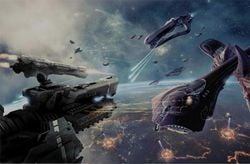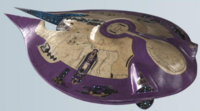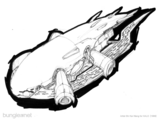Seraph: Difference between revisions
From Halopedia, the Halo wiki
(I think the article should be moved to Seraph (fiction) for the sake of consistency.) |
BaconShelf (talk | contribs) |
||
| Line 23: | Line 23: | ||
</gallery> | </gallery> | ||
== | ==Operational history== | ||
Covenant forces have long made use of various Seraph patterns within their fleets.{{Ref/Note|This section details the use of unidentified Seraph patterns only. For specific appearances of named Seraph patterns, see the "Service history" sections in the articles for the [[Kai-pattern Seraph#Operational history|''Kai''-pattern]] and ''[[Morsam-pattern Seraph#Operational history|''Morsam''-pattern]]''.}} | Covenant forces have long made use of various Seraph patterns within their fleets.{{Ref/Note|This section details the use of unidentified Seraph patterns only. For specific appearances of named Seraph patterns, see the "Service history" sections in the articles for the [[Kai-pattern Seraph#Operational history|''Kai''-pattern]] and ''[[Morsam-pattern Seraph#Operational history|''Morsam''-pattern]]''.}} | ||
Revision as of 14:04, October 31, 2022

Seraphs are combat space fighters used by armed forces of the Covenant empire and its fleet, and inherited by its splinter factions.[1]
Summary
Design details
The Seraph features a piscine, teardrop-like shape, fitting with the overall design elegance the Covenant is known for. Seraph fighters are mostly stored in the hangar bays of Covenant ships or stations when they are not in battle or escorting a ship. Morsam-pattern Seraphs have two movable flaps on either side of their hull, and their twin "tails" are articulated to aid with directing exhaust, while those on the Kai-pattern are fixed. These features give the Seraph superior turning capabilities in zero-gravity environments. Despite their efficiency and speed in space, Seraph fighters are graceless and sluggish in atmospheric conditions due to their odd teardrop-like shape. Seraphs fill a variety of roles in a Covenant fleet, such as a strike fighter or for ship-to-ship combat in dogfights.[2] Seraphs can also be used for the occasional bombing run,[3] but it is considered a rare sight by UNSC forces.[4] Seraphs have the ability to power down and slip past hostile sentries and human sensors.[5] Unlike the Banshee or the Phantom dropship, Seraphs are equipped with multiphase energy shielding,[4] although some Seraphs may have been seen not always using their energy shields.[6] However, these energy shields are only a fraction of the strength of those on capital ships and are easily depleted with sustained fire.[7]
As the Covenant's main space-based attack fighter, the Seraph is highly maneuverable while in space, and can easily keep pace with the UNSC's GA-TL1 Longsword.[3]
Armaments
Seraphs have demonstrated that they are a very effective counter-weapon against Longsword interceptors unless the latter attacks from the side or behind. Seraphs usually attack in formations of ten, their assaults on enemy ships range from simple harassment to full out strafing attacks. They have also been seen patrolling in pairs. It is assumed that Seraph fighters can be piloted by a single Sangheili or Jiralhanae.[3]
The Seraph is armed with a variety of weapons. Seraphs are seen firing a heavy plasma cannon, and are also armed with a pulse laser and plasma charges for strafing and bombing runs.[3] A Seraph's bombing runs are very deadly, as evidenced in Operation: TORPEDO, the SPARTAN-III Beta Company's attack on a Covenant refinery on Pegasi Delta.[4] The Seraph's energy weapons deliver a hard punch to anything it attacks, such as D77-TC Pelican dropships,[8] and when dueling with the UNSC space-superiority FSS-1000 Sabres.[9] A Seraph was also capable of doing some damage against a Halcyon-class light cruiser's Titanium-A armor plating.[5]
Types
Operational history
Covenant forces have long made use of various Seraph patterns within their fleets.[Note 1]
Human-Covenant War
On March 26, 2526, Spartan-II Blue, Gold, and Green Teams led a mission to destroy the logistics fleet serving the Fleet of Inexorable Obedience. In orbit over Etalan, the Gold and Green Teams piloted four S-14 Baselards alongside sixteen other Baselards. To accomplish their goal of destroying four Covenant equipment freighters, the Baselards had to fight through swarms of Seraphs and Elsedda-pattern Banshees.[10]
Seraphs have seen operational use as early as the Harvest campaign, and would later become a common adversary of Longsword fighters. These starfighters provided excellent fire support to all Covenant forces in space and on the groundside. Elite pilots considered piloting a Seraph merely a means to attain enough glory to be reassigned to a ground combat position, valuing their fighters only as tools to accomplish this. Despite their extensive training, their honor code gave them a tendency to peel off from their squadrons to engage in one-on-one dogfights, making them vulnerable in combat. Brute pilots were excluded from such training, but their pack mentality and rigid social hierarchy made them far more effective teams. Human pilots soon learned to fear Brute-piloted Seraphs, identified by clan markings and Forerunner symbols carved on their hulls, more than Elite-piloted Seraphs.[11]
In Operation: TORPEDO, the Seraphs harassed the incoming SPARTAN-IIIs by bombarding them during the UNSC surprise assault of the Covenant refinery facilities. Several fighters were shot down by missiles fired from the M19-B surface-to-air missile launchers used by the SPARTAN-IIIs.[4]
Related vehicles
- Elsedda-pattern Banshee - Similar in role to the Seraph, Type-27 "Space Banshees" are often used to screen fighters and bombers.[12]
In-game information

|
See our gameplay information related to Seraph on its gameplay page. |
- Main article: Seraph
 This section needs expansion. You can help Halopedia by expanding it.
This section needs expansion. You can help Halopedia by expanding it.
Trivia

|
Browse more images in this article's gallery page. |
Instead of having a name that represents a sinister supernatural being like the Wraith or Phantom, the word "Seraph" is derived from the highest level of angels as described in certain texts of the Bible. However, Biblical seraphim have six wings while the Seraph has none.
Gallery
Early concept art of the Seraph for Halo: Combat Evolved.
Early design explorations for the Type-31 Morsam-pattern Seraph in Halo: Reach.
List of appearances
Notes
- ^ This section details the use of unidentified Seraph patterns only. For specific appearances of named Seraph patterns, see the "Service history" sections in the articles for the Kai-pattern and Morsam-pattern.
Sources
- ^ Halo: The Essential Visual Guide, p. 169
- ^ Halo Waypoint: Banshee Fighter
- ^ a b c d Halo Encyclopedia (2009 edition), p. 283 (2011)
- ^ a b c d Halo: Ghosts of Onyx, p. 17-22
- ^ a b Halo: The Flood, p. 12 (2010 edition)
- ^ Halo Legends, The Package
- ^ Halo: The Fall of Reach, p. 330 (2010 edition)
- ^ Halo: First Strike, p. 8-9 (2003 edition); p. 18-19 (2010 edition)
- ^ Halo: Reach, campaign level, Long Night of Solace
- ^ Halo: Silent Storm, chapter 19
- ^ Halo: Warfleet, p. 58-59
- ^ Halo Waypoint: Universe - Banshee
| |||||||||||||||||||||||||||||||||||||





